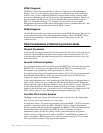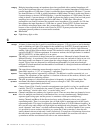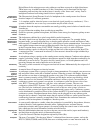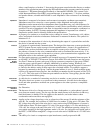
134 Handbook of Intercom Systems Engineering
those systems, the crosspoints are the actual switches that close or open to connect or disconnect
talk and listen paths. RTS™ ADAM™, ADAM™ CS, and Zeus™ Intercom Systems do not
actually use crosspoint switches, but use a technique called time division multiplexing (TDM), in
which communications are routed as digital packets. However, use of the term “crosspoint”
persists since packet routing basically accomplishes the same thing as conventional crosspoints:
namely, connecting distinct talkers and listeners. In this sense, a crosspoint can be thought of
simply as a communication link between any two points in the intercom system.
Crosstalk
Interference caused by audio energy from one line coupling (“leaking”) into adjacent or nearby
lines.
Current
A current is a flow of electrons past a point in a circuit and is measured in amperes (coulombs per
second). Practical currents in electronics are measured in: amperes, milliamperes one-thousandth
of an ampere, microamperes one-millionth of an ampere, nanoamperes one-thousandth of one
millionth of an ampere, picoamperes one-millionth of a millionth of an ampere, femtoamperes
one-thousandth of a picoampere
Current Sources
RTS™ Systems uses “Current Source” technology in many of its communications products. This
technology allows the summing of signals on a single pair of conductors across a single system
bus termination. This allows a distributed conference line system. Stations can be added
arbitrarily anyplace in the system. The system allows two to 75 stations to be put on the system
with only a maximum level difference of six decibels. The current source allows a signal to be put
on the bus without shorting out the other signals.
D
Daisy Chain
Some TW user stations allow the stringing together (or daisy chaining) of user stations. These
stations have a “loop through” or “extension” connector as well as a ‘line” or “line input”
connector. Connecting up a TW system by connecting one user station to another via the line and
loop through or “ext” connectors. This is as opposed to “home running,” which is running a cable
from each user station to a central point (“home”).
dB
Decibel, see definition for decibel.
dBm
A reference level where 0 dBm equals 1 milliwatt. In a 600 ohm system 1 milliwatt corresponds
to a voltage of 0.775 volts.
dBu
A reference level where 0 dBu equals the voltage as a dBm (0.775 volts) but without the 600
ohms in the circuit.
DC
Direct Current. Example: current as from a battery.
decibel (dB)
1. One-tenth of a bel. It is equal to 10 times the logarithm of the power ratio, 20 times the log of
the ratio of voltages or currents. Three decibels increase represents a doubling of power, six
decibels increase represents four times the power or a doubling of the voltage in a circuit. 2. A
derived unit of loudness. The human ear perceives a 10 decibel increase as twice as loud, and a 10
decibel decrease as half as loud.
Dedicated Line
1. A term used by some to indicate a single path in a point-to-point system. 2. A term used instead
of point-to-point or matrix system, for example: a dedicated line system. (This term seems to be
more marketing than engineering oriented).
Destination
A destination is anything that a talk key talks to or a listen key listens to. A destination can
therefore be any port, Party-Line, IFB, etc.
Dielectric
An insulating (nonconducting) medium or material.
Dim
“Dim” occurs in two contexts in RTS™ Digital Matrix Intercom Systems.First, there is the Dim
Table feature. Dim tables are used to correct a feedback problem that can occur between two
keypanels operating in close proximity that have keys assigned to talk/listen to a common
destination. Dim tables are set up in AZ™EDIT (search for keyword “dim” in AZ™EDIT help.
Once a dim table is set up, it can be assigned as a level 2 talk assignment for those keys that are
causing the feedback problem. For information about how to make this assignment from a
programmable keypanel, search for “Dim Table” in the keypanel manual index.There is also an
adjustable speaker dim feature available on the KP-32 Keypanel. This causes the speaker or


















